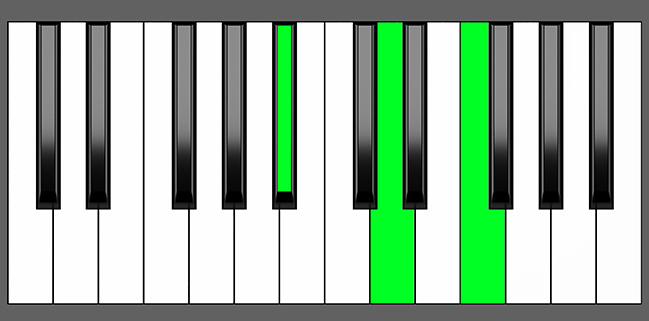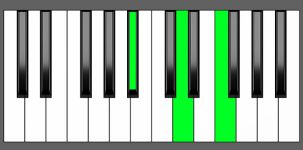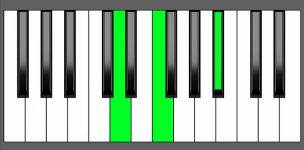Piano Diagram of Bb Major in Root Position

To get a Bb Major chord, you combine the root (Bb), the 3rd (D), and the 5th note (F) from the Bb major diatonic scale. In other words, a Bb Major chord is a major triad built upon the key of Bb. Keep reading to get a better grip on the music theory behind this fundamental chord.
Structure of Bb Major
Notes |
|---|
| Bb, D, F |
Intervals |
|---|
| R, 3, 5 |
Fingers Position
Left Hand |
|---|
| 4, 2, 1
5, 3, 2 |
Right Hand |
|---|
| 1, 2, 4
1, 3, 5 |
Bb Major Chord Inversions
The Bb Major chord has a total of 2 inversions:
| Root Position: | Bb | D | F |
| 1st Inversion: | D | F | Bb |
| 2nd Inversion: | F | Bb | D |
Piano Keyboard Diagrams
Music Theory and Harmony of Bb Major
What are Major Chords?
Major chords are one of the two primary types of chords in music, along with minor chords. The primary distinction between the two lies in the 3rd note of the chord – major chords use a major 3rd, while minor chords use a minor 3rd. Due to the major third interval, major chords generally evoke a “happy” or “bright” quality, creating a sense of stability and resolution.
Building the Bb Major Chord: Different Approaches
Starting from the Bb Major Scale
To build a major chord, you can use the major scale as a reference. You will need to combine a root, a major 3rd, and a 5th interval.
For instance, to build the Bb Major chord, you can start with the Bb Major scale.


To create a Bb Major chord, apply the formula R, 3, 5 in the following manner:
- Begin with the root note, which is Bb.
- Select the major 3rd interval, which is D, and add it to the chord.
- Finally, add the 5th interval, which is F.
By following this simple formula, you can create a major chord from any major scale.
by Combining Intervals
One method to create a major chord is by combining specific intervals – a major 3rd, and a minor 3rd. For example, let’s consider the Bb Major chord.
3 + m3 = Major Chords
By examining the intervals between the notes, we can see that Bb-D forms a major 3rd interval, and D-F creates a minor 3rd interval. These two intervals can be stacked together to create the Bb Major chord.
How to Use Bb Major in a Chord Progression
The following tables display the harmonization of major and their relative natural minor scales for keys that contain a Bb Major chord in different positions (degrees of the scale).
on Major Scales
| Major Scales | I | ii | iii | IV | V | vi | vii |
|---|---|---|---|---|---|---|---|
| Bb | Bb Maj | C min | D min | Eb Maj | F Maj | G min | A dim |
| F | F Maj | G min | A min | Bb Maj | C Maj | D min | E dim |
| Eb | Eb Maj | F min | G min | Ab Maj | Bb Maj | C min | D dim |
- Tonic chord in Bb Major
- Subdominant chord in F Major
- Dominant chord in Eb Major
on Natural minor Scales
| Minor Scales | i | ii | III | iv | v | VI | VII |
|---|---|---|---|---|---|---|---|
| G | G min | A dim | Bb Maj | C min | D min | Eb Maj | F Maj |
| D | D min | E dim | F Maj | G min | A min | Bb Maj | C Maj |
| C | C min | D dim | Eb Maj | F min | G min | Ab Maj | Bb Maj |
- Mediant chord in G minor
- Submediant chord in D minor
- Leading tone chord in C minor
Bb Major Chord Function in Major and Minor Keys
Understanding Scale Degrees
When creating chords from a scale, each note in the scale is assigned a degree, which reflects its position in the scale. In the diatonic major scale, there are seven degrees, and each degree has a unique role in the overall harmony of the scale.
- The first degree of the scale is called the Tonic, and it serves as the foundation for the scale. It provides a stable tonal center and is often referred to as the “home base” of the music.
- The second degree of the scale is called the Supertonic. It’s typically used as a passing note between the tonic and other scale degrees, and it adds a sense of movement to the melody or harmony.
- The third degree of the scale is called the Mediant. It’s located halfway between the tonic and dominant notes and helps to establish whether the scale is major or minor.
- The fourth degree of the scale is called the Subdominant. It’s often used as a complementary harmony to the dominant and adds a sense of tension and resolution to the music.
- The fifth degree of the scale is called the Dominant. It generates tension and a sense of expectation, and it’s typically resolved by returning to the tonic.
- The sixth degree of the scale is called the Submediant. It’s often utilized as a transition between the dominant and tonic, and it provides a sense of stability and restfulness to the music.
- The seventh degree of the scale is called the Leading tone. It’s located one half step below the tonic and produces a strong sense of tension and a desire to resolve to the tonic. It’s often used to create a sense of resolution and finality in the melody or harmony.
Bb Maj in A Major
The Bb Major chord is the first chord in the harmonized Bb major scale. In a major key, the I chord serves as the tonic chord, providing the harmonic center of the chord progression.
| I | ii | iii | IV | V | vi | vii |
| Bb Maj | C min | D min | Eb Maj | F Maj | G min | A dim |
Bb Major Chord Progressions as I degree
Play these chord progressions to get an idea of how Bb Major functions as the tonic (I degree).
ii V I
| ii | V | I |
| C min | F Maj | Bb Maj |
I IV V
| I | IV | V |
| Bb Maj | Eb Maj | F Maj |
I V vi IV
| I | V | vi | IV |
| Bb Maj | F Maj | G min | Eb Maj |
I IV vi V
| I | IV | vi | V |
| Bb Maj | Eb Maj | G min | F Maj |
Bb Maj in F Major
The Bb Major chord can also be found on the fourth degree of the F major scale. In the I-IV-V progression, the chord on the fourth degree serves as a transitional chord between the first and fifth degrees.
| I | ii | iii | IV | V | vi | vii |
| F Maj | G min | A min | Bb Maj | C Maj | D min | E dim |
Bb Major Chord Progressions as IV degree
Practice playing these chord progressions to grasp the role of Bb Major as the subdominant (IV degree).
I IV V
| I | IV | V |
| F Maj | Bb Maj | C Maj |
I V vi IV
| I | V | vi | IV |
| F Maj | C Maj | D min | Bb Maj |
I IV vi V
| I | IV | vi | V |
| F Maj | Bb Maj | D min | C Maj |
Bb Maj in Eb Major
The Bb Major chord is a significant chord in the Eb Major scale as it can be found on the fifth degree (V). When in this position, it serves a dominant function, meaning it creates tension and a sense of resolution toward the tonic chord (I).
| I | ii | iii | IV | V | vi | vii |
| Eb Maj | F min | G min | Ab Maj | Bb Maj | C min | D dim |
Bb Major as V degree – Chord Progressions
ii V I
| ii | V | I |
| F min | Bb Maj | Eb Maj |
I IV V
| I | IV | V |
| Eb Maj | Ab Maj | Bb Maj |
I V vi IV
| I | V | vi | IV |
| Eb Maj | Bb Maj | C min | Ab Maj |
I IV vi V
| I | IV | vi | V |
| Eb Maj | Ab Maj | C min | Bb Maj |
I IV ii V iii vi ii V
| I | IV | ii | V | iii | vi | ii | V |
| Eb Maj | Ab Maj | F min | Bb Maj | G min | C min | F min | Bb Maj |
Bb Maj in G Minor
Likewise, if we consider the G natural minor scale, we can locate the Bb Major chord as the third degree.
| i | ii | III | iv | v | VI | VII |
| G min | A dim | Bb Maj | C min | D min | Eb Maj | F Maj |
Bb Major Chord Progressions as III degree
These chord progressions can help you comprehend how Bb Major serves as the mediant (III degree).
i III
| i | III |
| G min | Bb Maj |
i III VII VI
| i | III | VII | VI |
| G min | Bb Maj | F Maj | Eb Maj |
i III iv v
| i | III | iv | v |
| G min | Bb Maj | C min | D min |
i III ii v
| i | III | ii | v |
| G min | Bb Maj | A dim | D min |
I iii vi V
| i | III | VI | iv |
| G min | Bb Maj | Eb Maj | C min |
Circle Progression
| i | iv | VII | III | VI | ii | V | i |
| G min | C min | F Maj | Bb Maj | Eb Maj | A dim | D Maj | G min |
(This chord progression is commonly used in many musical genres. It’s called a circle progression because if you continue through the sequence, you will eventually return to the starting point, forming a “circle” of keys.)
Bb Maj in D Minor
Another instance where you can come across a Bb Major chord is while playing in the key of D. In fact, the Bb Major chord can be found on the sixth degree of the D minor scale.
| i | ii | III | iv | v | VI | VII |
| D min | E dim | F Maj | G min | A min | Bb Maj | C Maj |
Bb Major Chord Progressions as VI degree
Try playing these chord progressions to get a sense of how Bb Major sounds as the submediant (VI degree).
i VI VII
| i | VI | VII |
| D min | Bb Maj | C Maj |
i v VI VII
| i | v | VI | VII |
| D min | A min | Bb Maj | C Maj |
i III VII VI
| i | III | VII | VI |
| D min | F Maj | C Maj | Bb Maj |
Circle Progression
| i | iv | VII | III | VI | ii | V | i |
| D min | G min | C Maj | F Maj | Bb Maj | E dim | A Maj | D min |
Bb Maj in C Minor
In the C natural minor scale (which is the relative minor scale of Eb major), the Bb Major chord can be found on the VII degree. In this position, it serves as the leading tone chord, which creates a sense of tension and resolution towards the tonic chord (C minor).
| i | ii | III | iv | v | VI | VII |
| C min | D dim | Eb Maj | F min | G min | Ab Maj | Bb Maj |
Bb Major as VII degree – Chord Progressions
To hear how the Bb Major chord functions as the leading tone (VII degree) in a chord progression in C minor, you can play the following chord progressions:
i VI VII
| i | V | VII |
| C min | G min | Bb Maj |
i v VI VII
| i | v | VI | VII |
| C min | G min | Ab Maj | Bb Maj |
i III VII VI
| i | III | VII | VI |
| C min | Eb Maj | Bb Maj | Ab Maj |
Circle Progression
| i | iv | VII | III | VI | ii | V | i |
| C min | F min | Bb Maj | Eb Maj | Ab Maj | D dim | G Maj | C min |
Alternative Names for Bb Major
- Sib +
- Bb M
- Sib M
- BbMaj
- Bb Maj
- Bbmag
- Bb Magg
- Sib Magg


